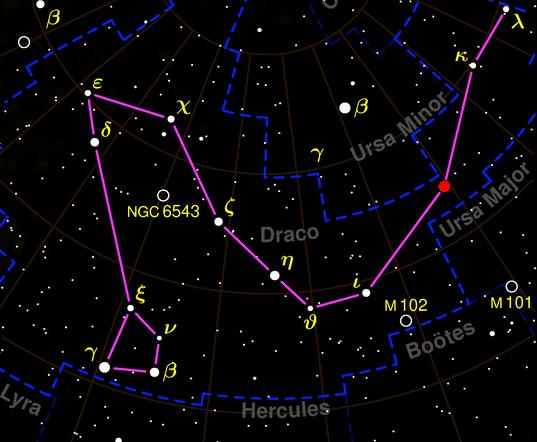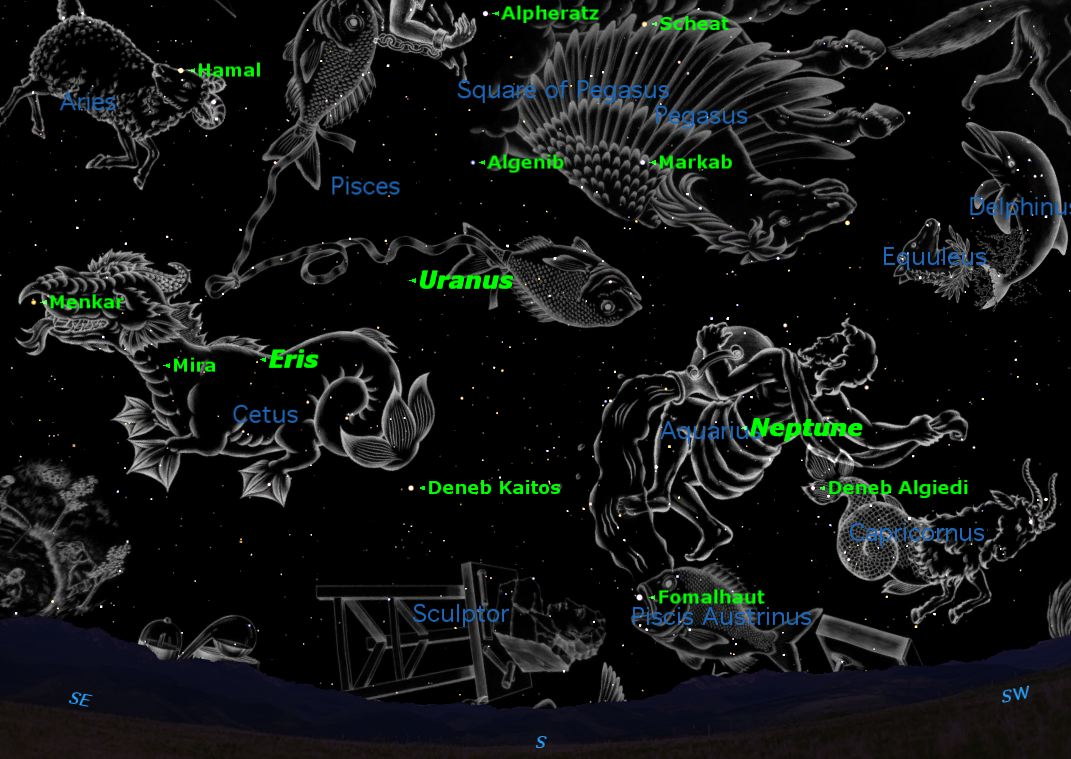Draco Constellation: Facts About the Dragon

Despite its size and designation as the eighth-largest constellation, Draco, the "dragon" constellation, is not especially prominent. The name is derived from the Latin term draconem, meaning "huge serpent," and the constellation literally snakes its way through the northern sky.
Locating Draco
Draco is circumpolar, meaning that it never sets below the horizon and is always visible in the Northern Hemisphere, but cannot be seen in the Southern Hemisphere.
- Right ascension: 17 hours
- Declination: 65 degrees
- Visible between latitudes 90 and minus 15 degrees
- Best seen in July at 9 p.m. local time

Stars, galaxies and planets
Draco's stars are not very bright. The head of the dragon consists of four stars (Beta, Gamma, Nu and Xi Draconis) in a trapezoid and located just north of Hercules. From there, the dragon's body winds its way through the sky, ending between the Big Dipper and Little Dipper. From early to mid-October, a meteor shower known as the Draconids appears to radiate from Draco's head.
Kepler Reveals Lots of Planets: Some Habitable?
Other stars in the constellation include Thuban (Alpha Draconis), which forms the tail. Because Earth wobbles on its axis (called precession), Thuban was the pole star around 2600 B.C. when the ancient Egyptians were building the pyramids.
Draco consists of several double stars, including Eta Draconis and 20 Draconis.
The Cat's Eye Nebula is also contained within the constellation. [Gallery: Strange Nebula Shapes, What Do You See?]
The constellation encompasses several faint galaxies, including the Draco Dwarf Galaxy, one of the least luminous galaxies with a diameter of about 3,500 light years.
A handful of exoplanets have been found in Draco so far, such as:
- Kepler-10b (around the star Kepler-10), which was the smallest rocky Earth-sized planet detected outside of the solar system when it was announced in 2011. [Kepler Reveals Lots of Planets: Some Habitable?]
- Kepler-10c, which has the same parent star, was nicknamed "the Godzilla of Earths" after it was announced in 2014. This is because the rocky world has a mass that is 17 times that of Earth, making it likely to be more of a "mini-Neptune" than a "super-Earth," with a thick gaseous envelope.
- A Jupiter-sized planet called TrES-2b was announced in 2011, and found orbiting the sun-like star GSC 03549-02811. The star only reflects about 1 percent of the light that falls on it, and was classified the darkest planet yet found at the time of its discovery.
Mythology
The name Draco has been linked to several dragons in Greek mythology. One version is that Cadmus slayed the dragon Draco in his quest to find his sister, Europa, who had been taken to Crete by Zeus. In another account, the Athenian goddess Minerva took Draco by the tail and put it into the sky during the battle for Mount Olympus. Draco has also been identified in early Christianity as the serpent that tempted Eve in the Garden of Eden.
Additional reporting by Elizabeth Howell, Space.com Contributor.
Related:
- How the Night Sky Constellations Got Their Names
- Constellations: The Zodiac Constellation Names
- Constellation Orion: Facts About the Hunter
- Constellation Pegasus: Facts & Notable Features
- Constellation Gemini: Facts About the Twins
- Leo Constellation: Facts About the Lion
- Scorpio Constellation: Facts About the Scorpion
- Cancer Constellation: Facts About the Crab
- Virgo Constellation: Facts About the Virgin
- Aries Constellation: Facts About the Ram
- Taurus Constellation: Facts About the Bull
Join our Space Forums to keep talking space on the latest missions, night sky and more! And if you have a news tip, correction or comment, let us know at: community@space.com.
Get the Space.com Newsletter
Breaking space news, the latest updates on rocket launches, skywatching events and more!
Kim Ann Zimmermann is a contributor to Space.com and sister site Live Science, writing mainly evergreen reference articles that provide background on myriad scientific topics, like the constellations, astronauts, climate, culture and medicine. Her work can also be found at Business News Daily and KM World. She holds a bachelor’s degree in communications from Glassboro State College.










